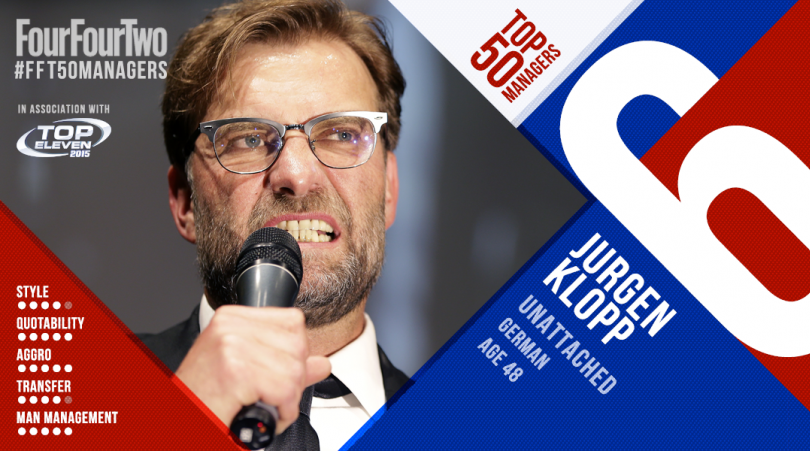Training time, tactics tweaks and enduring love: How Klopp averted a crisis
In spring, as Dortmund tried to ease themselves away from the drop zone, Uli Hesse examined Jurgen Klopp’s approach to the club’s crisis – and the chances of a move to England...
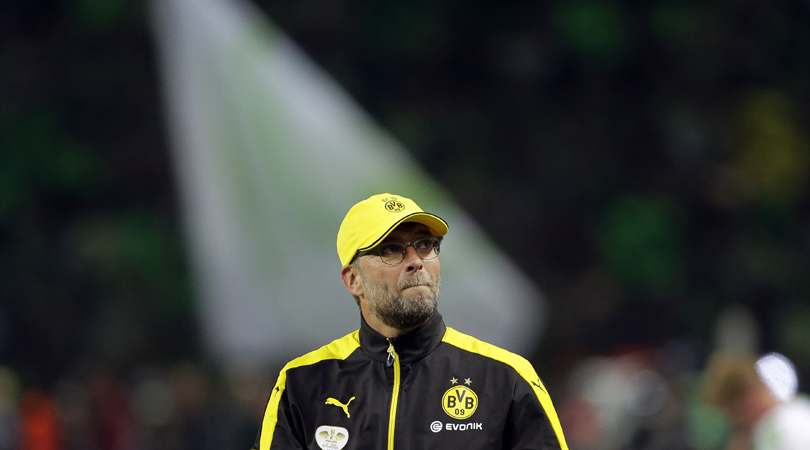
The reason Dortmund fans have been so patient is the personality of the coach – he is still immensely popular
It’s one of the many perplexing side issues in the mysterious tale of Dortmund’s fall from grace that even die-hard fans whose entire lives revolve around the club watched the decline with the serenity of Tibetan monks. Actually, it almost seemed as if the support grew more understanding and forgiving the worse the results became.
When their team dropped into the relegation zone by losing 1-0 at Hertha Berlin last December, the travelling Dortmund fans chanted “Borussia, Borussia!” until the players, their heads bowed, walked over to the curva. And then the entire away stand sang a popular terrace song which states that the club is everyone’s pride and joy. It gave even the neutrals at the ground goosebumps.
“I think there are three reasons why the fans were so patient,” says Dortmund fan Jan-Henrik Gruszecki. “The first is they haven’t forgotten that this very team has given them so much to celebrate. The second is the personality of the coach. He is still immensely popular. And the third is the skill of the coach. The fans knew that Klopp had been in many relegation fights with Mainz. So the feeling was that someone like Pep Guardiola might not be able to cope with a situation like this, but Klopp could.”
Truth be told, he didn’t always look the part. Klopp sometimes wore such a pained expression on his face during the first half of the season that his former player Patrick Owomoyela, now a pundit, remarked on television: “At the moment he comes across as quite helpless and defensive. I don’t think he would be above saying: ‘Well, maybe I’ve done all I could do here, and now somebody else must come and help.’”
Many supporters, however, interpreted Klopp’s distress differently. They’d always loved him for his emotions, for wearing his heart on his sleeve. When things went well, this meant he would be celebrating wildly and cheering the team, just like any regular fan. But of course it also meant that when things were going wrong, he would be visibly frustrated, just like the people in the stands.
And so it wasn’t until a home defeat in early February, by an Augsburg team reduced to 10 men, that the fans finally reached the end of their tether. For the first time, boos and catcalls rang around the ground so forcefully that after the final whistle the players kept a respectful distance to the Sudtribune terrace and sent their two captains, goalkeeper Roman Weidenfeller and defender Mats Hummels, over to the fence to discuss the team’s performance with the ultras.
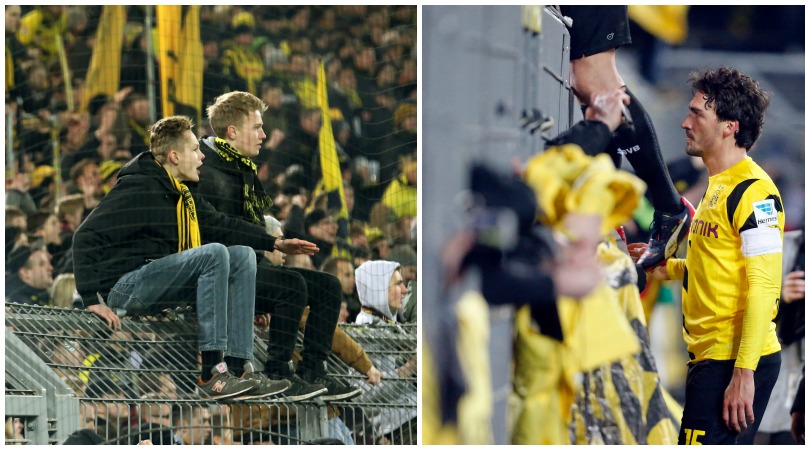
Interestingly, this game marked the end of Borussia’s rough patch. Three days later the team scored three goals without reply at Freiburg. It was Dortmund’s first league victory in 64 days, and the starting point of a four-game winning streak highlighted by an impressive 3-0 derby triumph over fierce rivals Schalke.
Get FourFourTwo Newsletter
The best features, fun and footballing quizzes, straight to your inbox every week.
An incredibly emotional afternoon was capped by Pierre-Emerick Aubameyang and Marco Reus celebrating the first goal by donning Batman and Robin masks, prompting predictable headlines proclaiming the ‘Return of Dortmund’s Superheroes’.
Where did it all go wrong?
Whoever says that this team has motivational problems suffers from Alzheimer’s disease
What is much harder to pinpoint, though, is when the rough patch began – and why. Gruszecki reckons Borussia started to unravel away at Mainz, on matchday four. With Dortmund a goal down, the visitors were awarded a penalty. In-form attacker Aubameyang was ready to take it, but Italian centre-forward Ciro Immobile, a new signing understandably eager to prove himself, grabbed the ball and placed it on the spot. His shot was saved and Dortmund went on to lose a game they should have never lost – for the first but certainly not the last time that season.
However, it wasn’t Dortmund’s first defeat of the campaign. And so there are others who say that the drama really began to unfold during the first eight seconds of the season. On opening day, Bayer Leverkusen travelled to Dortmund, scored the fastest goal in Bundesliga history and deservedly bagged three points against a Borussia side that never recovered from falling behind so quickly.
Some claim the seeds of struggle were in fact sown way back in summer 2014. Dr Jeannine Ohlert, a sports psychologist, told Sky Austria that things went wrong as early as the pre-season preparations, when “some players came back from the World Cup exhausted and struggling to find motivation”.
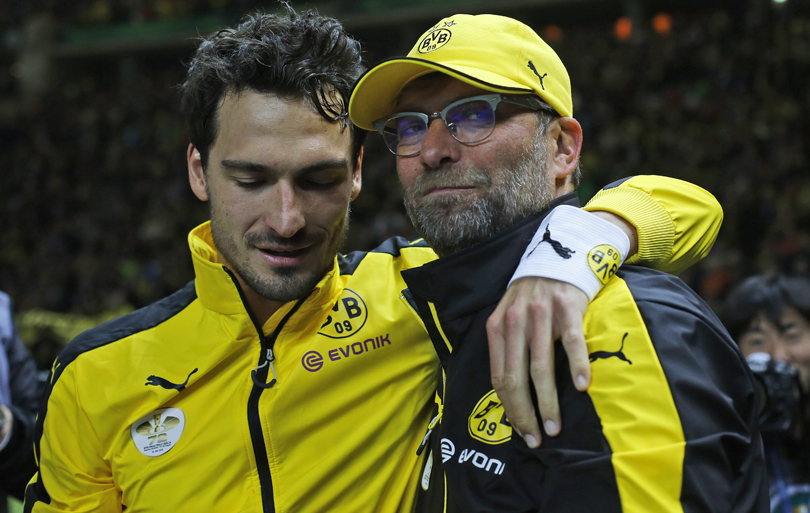
The second bit may sound improbable, but it’s not a far-fetched theory. Over the previous four seasons, Borussia Dortmund and Bayern Munich had become so dominant in Germany that most observers considered the top of the league table a foregone conclusion. And if one of the two giants should slip up really badly then the worst that could happen to them, many fans felt, was that they dropped to third or fourth place. Bearing this in mind, it’s not inconceivable that the players themselves subconsciously felt they might get by with giving only 95% on a few occasions.
Not that you should ever dare to mention this theory in Klopp’s presence, though. In October he told a reporter: “If this was our problem, I’d be the first to give the players a kick up the backside each day of the week.” Then he angrily added: “Whoever says that this team has motivational problems suffers from Alzheimer’s disease.”
But it was a tempting argument. How else could you explain the discrepancy between Dortmund’s league form and their Champions League performances? In mid-September, Klopp’s side played Arsenal off the park in a commanding manner. Four days later, they lost at Mainz and then didn’t win another Bundesliga game until November.
At the press conference following the home defeat against Hamburg, Klopp was asked to give his own explanation for the striking difference between the fine results in Europe and the poor showings in the Bundesliga. Wearing his usual Borussia hoodie and looking as if he’d aged five years over the previous five months, the coach furrowed his brow.
“Form, that’s all,” he said. “We have players who can summon their form on some days, but on some others they cannot do this.” He went on to explain that there were several reasons for this but that the most important one was an almost absurd number of injuries.
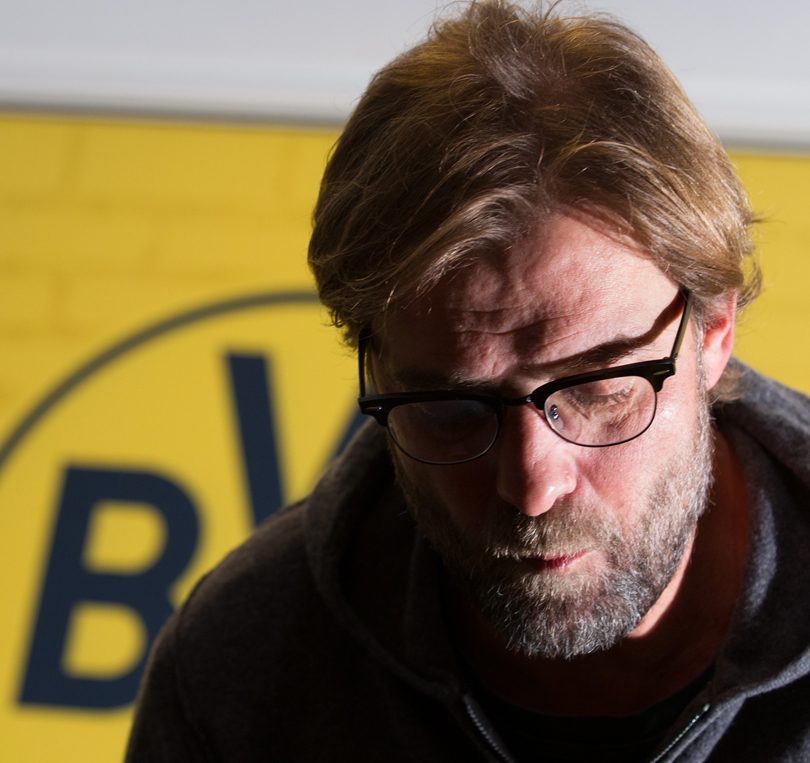
“We have players who are coming off lengthy lay-offs but who can’t be eased into the side now – they immediately have to be on top of their game,” he said, meaning someone like Ilkay Gundogan, who had been sidelined for no fewer than 430 days with back problems. Klopp added: “We also have players who had only a very short pre-season preparation but need to play in every game now.” He was referring to players like Hummels, who had come back from the World Cup with a nagging injury.
So it takes just a few injuries and some rotten luck to turn one of the best teams in Europe into a bunch of donkeys? In January, with Bayern in first place, Dortmund in last and 29 points separating the two pre-season favourites, Pep Guardiola said: “What happened to Dortmund can happen to us, too. In football, you can never relax. At any given moment, anything can happen.”
What happened to Borussia was that a simple run of bad results slowly but surely turned into a self-fulfilling prophesy. If you ever wondered how important the mental aspect of the game is and how quickly a player can lose confidence, all you had to do was watch Henrikh Mkhitaryan. The Armenian playmaker, one of the most naturally gifted footballers in the whole of Europe, gradually became so consumed by fear – fear of another stray pass, another wasted chance, another defeat – that Klopp finally had to bench him.
Because make no mistake, even if the fans were totally behind the team and trusted their beloved coach with finding a way out of this mess, he had to do something – and fast. On the day the club celebrated its 105th birthday, December 19, Jan-Henrik Gruszecki told a club representative: “If we lose tomorrow, in Bremen, we are in serious trouble.” They did and they were.
At the moment we look like complete idiots, and it serves us right. But we’ll be back, looking different
“All I can say is: I wouldn’t write us off,” Klopp said after this game, standing on the pitch in Bremen and having to explain his team’s 10th league defeat. He defiantly added: “At the moment we look like complete idiots, and it serves us right. But we’ll be back, looking different.” He was right. But what ultimately saved him was that great German football invention – the winter break.
Klopp: Dortmund’s Steve Jobs
Another perplexing aspect of Dortmund’s mysterious fall from grace was that the men who run the club were apparently prepared to go down rather than part company with their coach. During the winter break, the magazine Sport Bild asked the club’s chairman, Hans-Joachim Watzke, how safe the manager’s job was.
“We will never dismiss Jurgen Klopp,” Watzke replied. “The services he has rendered to Borussia are exceptional. No confrontational situation will ever arise.” Four weeks later, after the Augsburg debacle and with the team still in last place, Watzke renewed his promise, adding that the club’s faith in Klopp was “beyond debate and doubt”. Saying that this was a most unusual state of affairs would be an understatement. Only once before in league history had a reigning runner-up sunk as far as last place this deep into a season. That team was Alemannia Aachen in 1969-70. Needless to say, they sacked their coach as early as December (and still went down).
The only fairly recent comparable case that comes to mind concerns Bayer Leverkusen. Under coach Klaus Toppmoller, the team reached the 2002 Champions League Final and the domestic cup final, and finished second in the league, playing tremendous entertaining football along the way. Months later, in February 2003, Leverkusen found themselves in a relegation spot – and the club’s then-business manager Rainer Calmund announced that to his “greatest regret” he “didn’t have a choice” but to fire the coach.
Watzke could have done the same without losing face – or a friend – because everyone, not least Klopp himself, would have understood that football clubs can’t afford to be sentimental. That Watzke stood firm regardless wasn’t met with universal admiration.
In a much-publicised interview in late January, the columnist and philosopher Wolfram Eilenberger compared Borussia to a sect. “A crisis calls for an honest analysis,” he said. “But that’s not possible in Dortmund, because seeing the coach as the cause of the crisis is taboo.”
In Dortmund, seeing the coach as the cause of the crisis is taboo
Eilenberger added: “I have spoken with many Dortmund fans, and the general thrust is: ‘We cannot imagine the club without Klopp’. Dortmund feels as dependent on Klopp as Apple used to be on Steve Jobs.” Eilenberger then drew a comparison with Arsenal, saying the Gunners were stagnating because Arsene Wenger had become unsackable. The philosopher, who also holds a German FA coaching badge, offered a simple solution for both clubs: “Klopp to Arsenal; Wenger to Dortmund.”
Perhaps Watzke viewed things differently because he had learned the hard way that bringing in a new coach may indeed put an end to stagnation, but that you can’t be sure in which direction you’ll start moving. Watzke became the club’s chairman in early 2005, when Borussia were on the verge of going bankrupt. The following year, a week before Christmas 2006, he fired the popular Dutch coach Bert van Marwijk, despite the fact that Borussia were in a perfectly respectable ninth place.
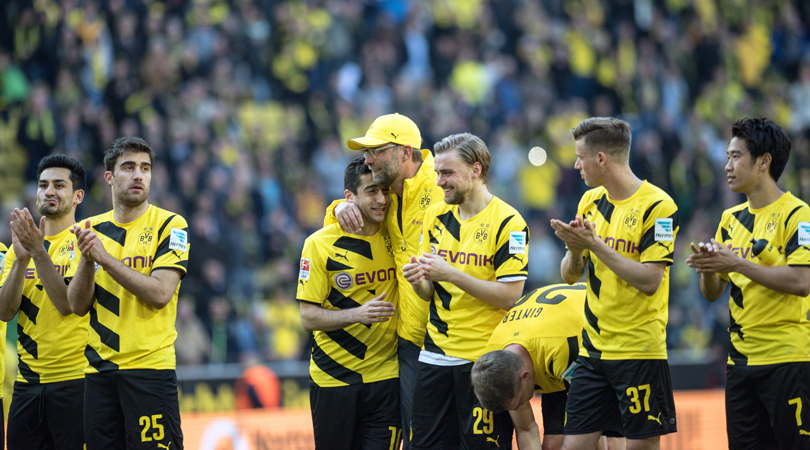
The dismissal threw the club into turmoil. Van Marwijk’s successor, Jurgen Rober, lost six of the next eight games. Suddenly Dortmund were only one point above the drop zone. It took another sacking and another coach – Thomas Doll, to whom Borussia’s fans never warmed – to avoid relegation at the 11th hour.
And so the board wouldn’t sack Klopp, and the fans wanted him to stay. However, that didn’t automatically mean he would last the season. As Owomoyela’s comment on television suggests, the longer the drama lasted, the more people could imagine that there would come a day when the coach himself felt he had taken this as far as he could and that now “somebody else must come and help”.
If it’s only about luck and if changing the coach brings this luck back, then just give me a call and a guarantee that it’s going to work – I won’t be standing in the way
Klopp himself fuelled such rumours after the Frankfurt game on the last day of November. Dortmund lost the match partly because of yet another unfortunate mishap at the back. A week earlier, Stuttgart coach Armin Veh had stepped down, saying that luck had deserted the club and he somehow felt responsible for this. Klopp was asked if he would follow Veh’s example, whereupon the Dortmund coach replied: “If it’s only about luck and if changing the coach brings this luck back, then just give me a call and a guarantee that it’s going to work – I won’t be standing in the way.”
Time takes time: How Klopp saved Dortmund
However, reading jadedness or even helplessness into such a comment was taking things too far. Because all through that almost comically terrible run, Klopp was very much aware that there was one powerful ace still up his sleeve. Gruszecki is right: although the circumstances of this one were highly unusual, the coach had been in relegation fights before, in the first division and the second. He knew that what you needed first and foremost was defensive stability. He also knew that all it took to restore that was time.
When Klopp was standing on that pitch in Bremen a few days before Christmas, he could promise the fans that, although all signs pointed to the contrary, his team would be back, looking different, because he knew he would now have six precious weeks to take the players’ minds off the league standings and work with the team on their problems. Not to mention that the physios would have time to get the injured players back into shape. If ever a Bundesliga team desperately needed the winter break, it was Borussia Dortmund.
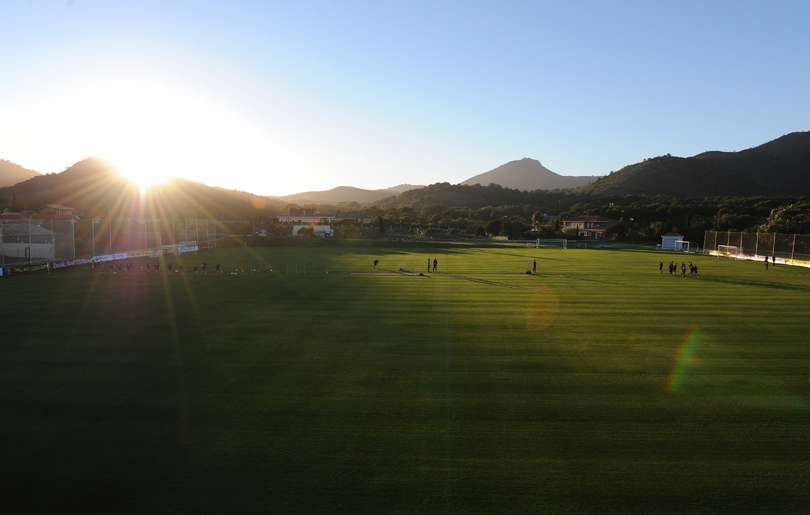
For the fourth time in a row, the club set up their winter training camp in a slightly remote resort near Murcia, in south-east Spain. It may be just a coincidence that in each of the previous three seasons, Dortmund had played better and with more success after the winter break. But if you’ve ever watched Klopp conduct one of those training sessions under the Spanish sun, you know there is a connection. The coach may have a reputation as a master motivator, but his aggressive pressing game is based on supreme organisation and he simply has more time to work on it during the quiet winter weeks than he has in the summer – especially a summer following a big tournament.
During the winter break, Klopp must have come to the conclusion that the situation called for another form of stability as well. Having experimented with various formations and line-ups during the first half of the season, he went back to the 4-2-3-1 system he had used almost without exception from October 2009 to May 2014. Shinji Kagawa was put in his old position, in the hole behind the lone striker. And this striker was Aubameyang. As much as Klopp liked the two forwards he had signed in the summer to replace Robert Lewandowski and provide extra options (Immobile and the Colombian Adrian Ramos), both now had to accept they were going to be subs, at least until the worst of the crisis was over.
During the winter break, Klopp must have come to the conclusion that the situation called for another form of stability as well
The same team that had kept only two clean sheets in the first half of the league season racked up five in the first eight games after the winter break. Dortmund conceded only five goals in those seven matches and climbed from last place to 10th in a little more than three weeks. While some fans took a furtive glance at the table to calculate if there were enough games left in the season to bridge the gap to the Champions League slots, Klopp said: “Even after four wins on the trot, we’re only five points above the relegation zone. That shows you in what kind of situation we were – and still are.”
The final perplexing facet of Dortmund’s season in hell was made public on the morning of February 10. With his team in 16th place in the 18-team Bundesliga, Marco Reus extended his contract until 2019. As the club later confirmed, the new contract didn’t include a get-out clause and was valid for the second division as well. When Reus walked into the dressing room an hour later to prepare for that day’s training session, the rest of the squad gave him a round of applause.
Hi Leute, ich freue mich euch mitteilen zu können, dass ich meinen Vertrag bis 2019 verlängert habe! @BVB Euer Marco pic.twitter.com/mXEuEhBrg7
— Marco Reus (@woodyinho) February 10, 2015
For the general public, this contract extension – later described by Klopp as “an extraordinary act” – came as a massive surprise. It was also deeply significant for the club’s support. A few months earlier, Bayern Munich chairman Karl-Heinz Rummenigge told a newspaper the much-coveted Reus could leave Dortmund “for a rumoured €25 million”. Ever since that disclosure, many fans feared Reus would be tempted to ‘do a Lewandowski’ (or Mario Gotze) and leave Borussia for Bayern. And even if he didn’t, chances appeared to be slim that he’d stay in Dortmund if the club failed to qualify for the Champions League.
When asked about his motivation, he said all the things a player should say. He mentioned that Dortmund was his hometown and how important his family and his friends were to him. Reus, who joined the club in 2012 after their back-to-back Bundesliga titles, also said that he dreamed of one day winning the league with Borussia just to see “what the city will be like then”, which echoed a point of view many fans take – that signing with Bayern to win silverware is the easy and therefore less satisfying route.
But most important of all was what Reus didn’t say, because he didn’t have to: that, like many other people in Dortmund, he didn’t have the slightest doubt the coach would find a way to avoid relegation.
Next?
By the spring of 2015, Eilenberger’s claim that Dortmund’s fans can’t imagine the club without Klopp had ceased to be true. For most supporters, there was at least one point during this cataclysmic season – maybe the Berlin game, probably the Bremen game, certainly the Augsburg game – when they simply had to entertain the thought that the pressure could become so strong that the coach might have to step down. In other words, they had to realise that the club is truly bigger than any one person.
One day, when we look back on this, we’ll find that the whole thing has brought the club closer together
Over the past few years, Klopp has been linked with numerous English clubs not only because he is rousing, engaging, entertaining and successful; it’s also because just when you think you’ve heard it all, he will offer a fresh and different perspective on an aspect of the game. And he did this again during Dortmund’s horrific run. A few days after the team had dropped into last place and most fans had begun to seriously fear for the future, he opened one of his regular press conferences by letting his gaze wander over a packed press room. Then he cracked a grin and said: “It hasn’t been this crowded in a long time. Is there a new rumour I don’t know about?”
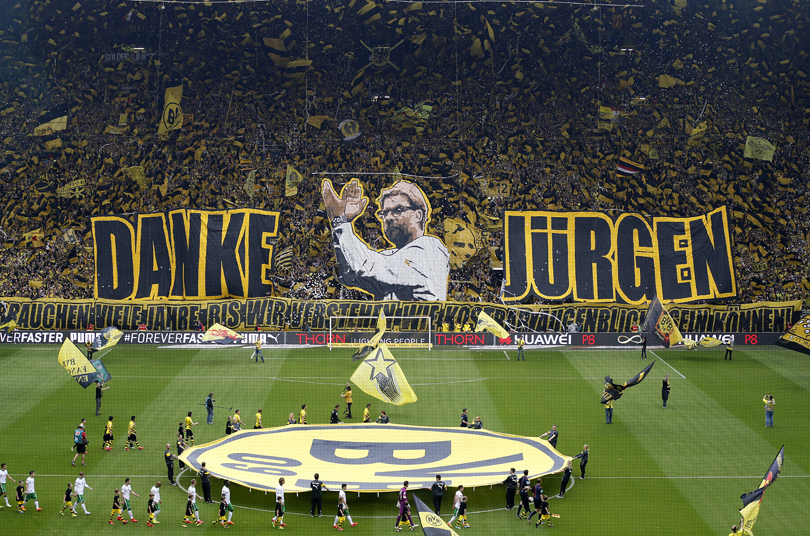
A few minutes later, he told the journalists: “One day, when we look back on this, we’ll find that the whole thing has brought the club closer together. We have the great chance to come out of this crisis stronger than we went in. But only if – perhaps for the first time in football history – we do it without allowing a wedge to be driven between us while we’re in the crisis.” They say you don’t know who your real friends are until the going gets tough. When the going got tough in Dortmund, Klopp found he has a lot more friends than he might have thought possible – in the stands, in the boardroom and in the team.
READ THIS NEXT The making of Jurgen Klopp
This feature originally appeared in the May 2015 issue of FourFourTwo magazine. Subscribe!
